Site menu:
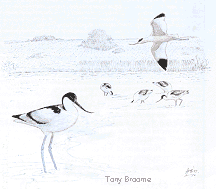
June 2016 Newsletter
Little Terns.
Colour Ring Report.
May Bird News.
Forthcoming Events.
Latest Newsletter.
Little Terns
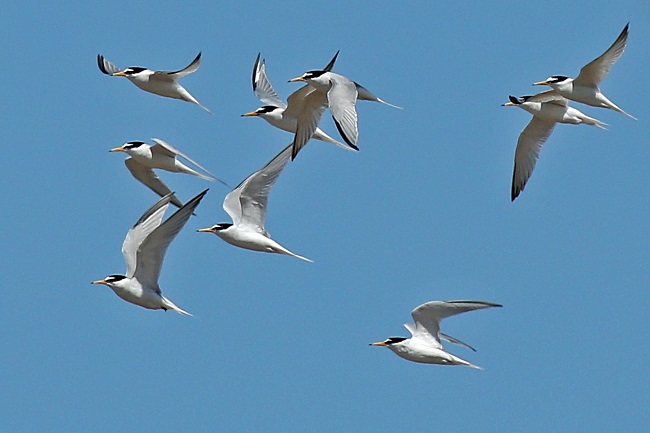
One of the highlights of the birdwatching year has to be the return of the Little Terns to Gronant. This year they were already present in good numbers with 45 on the early date of May 5th when the fences were being erected around the colony. It's well worth a visit there from early June, when nesting is well under way, until late July, when you should see the fledglings on the beach. It would be even better if you are able help protect what is one of the most successful Little Tern colonies in the UK, and the only one in Wales. Please ring Denbighshire Countryside Services for details (telephone 01745356197), email littleterns@denbighshire.gov.uk or just turn up at the colony and say hello to the wardens. There is a facebook page https://www.facebook.com/gronantlittleterns and a web page gronantlittleterns.tumblr.com/post/145219387203/welcome-to-the-2016-gronant-little-tern-season with further information. Also see "Gronant Little Terns - Appeal for Voluntary Wardens" in the June 2015 Newsletter, and Gronant Site Guide. This is a wonderful place to spend a few hours birdwatching, whether wardening or not.
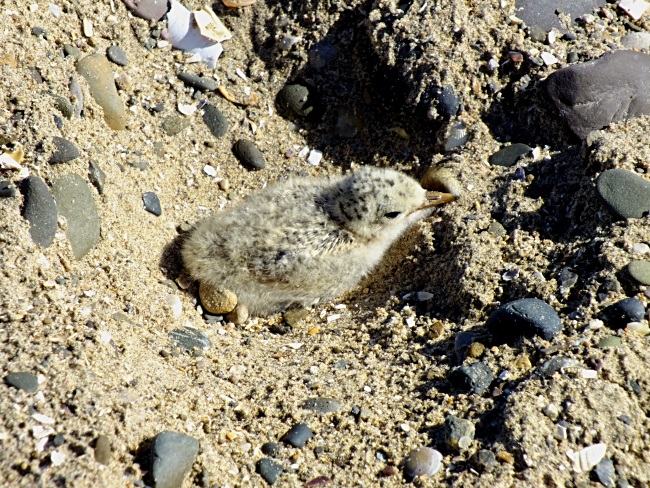
This photograph was taken several years ago, the chick had wandered on to the beach well away from the nest site.
The 2015 season.
The 2015 breeding season was quite eventful. It started well with an unusually high count of over 200 adults on the early date of May 19th, unfortunately there then followed two weeks of atrocious weather - gales and rain - just as the terns would normally start to nest. At one time we actually thought that they had completely deserted the colony and 20 pairs started to nest at nearby Point of Ayr (only one nest survived there). However, things did settle down eventually and 135 pairs bred (just one below the record high of 136 in 2014), and they produced 99 fledglings (plus one at Point of Ayr).
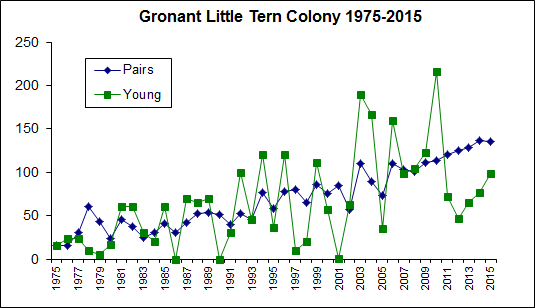
These are very satisfactory numbers, and it is the highest numbers of fledglings since 216 counted in 2010. It would have been a lot more successful if it wasn't for the kestrels taking a minimum of three adults, 33 chicks and eight fledglings. In 2016 the wardening team are planning to divert the kestrels by giving them food near their nest. I hope it works as we are overdue for a bumper season.
Little Terns in the UK
The total number of Little Terns breeding in the UK is estimated to be just under 2,000 pairs (measured as 'Apparently Occupied Nests'). Judging exactly how well this species is doing is difficult as numbers breeding and their productivity can vary wildly from year to year. This may be why the two graphs on the JNCC website seem to me to be contradictory with the UK abundance showing a slight decrease between 1994 and 2005 followed by a small increase from 2005 to 2014, yet the productivity graph (number of chicks fledged per pair) has fluctuated around 0.4 throughout that period. As it is reckoned that the productivity needs to be 0.7 for numbers to be stable then you would expect, with a productivity of only 0.4, that numbers would have dropped fairly sharply rather than remain stable. But no doubt it is a complex picture and perhaps the good years more than make up for the bad years. Incidentally, the productivity at Gronant in 2015 was 0.73, and the average since 2001 has been almost exactly 1.0, that is presumably why the Gronant colony continues to grow.
However, whether Little Terns are declining nationally in the short term or not, the longer term trend is definitely downwards and with the population being so small, and given their vulnerability to disturbance, the species is one of the UKs rarest seabirds and in need of our help. This is where the Little Tern Recovery Project, funded by EU Life+, comes in. This is a five year project with eleven organisations working together to ensure the Little Tern's long-term future.
The Project objectives are:1. Increase the total
population of little terns across the Project colony sites through
enhanced management of existing breeding sites and restoration and
creation of new or recently abandoned sites.
2. Protection of little terns and their nests and eggs from
threats such as disturbance and predation.
3. Improve the understanding of little tern population and
movements (demography) by undertaking a colour ringing programme to
inform long-term conservation strategies.
4. Monitoring using standardised recording across sites to
measure the success of the breeding attempts and feed this back to help
inform each successive annual summer work programme.
5. Local communities and other interested parties will learn about the
struggles of this scarce seabird, helping to raise support for the work
at the UK colonies.
6. Build up our knowledge and best practice case studies by increased
networking with other relevant projects in the UK, Europe and North
America.
7. Work with statutory agencies and local authorities to find ways to
support little tern conservation and extend the protection measures
when appropriate.
20 Little Terns were colour-ringed at
Gronant in 2015 as part of this project and a monitoring programme was
launched so that data collection was standardised across all the
colonies, including Gronant. Lets hope that the EU Life+ funding works
and we see good increases of Little Terns right across the country.
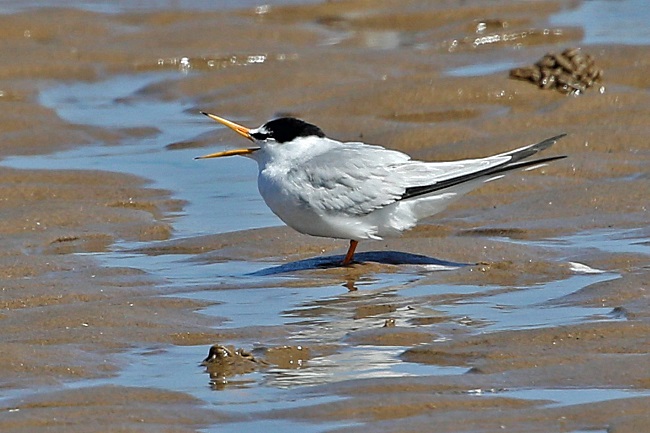
References and Further Reading
1. Jack Slattery, Coral Hansom & Stephen Hughes, Gronant Little Tern Report 2015, Denbighshire County Council Countryside Service.
2. Little Tern Sternula albifrons, Latest population trends, Joint Nature Conservation Committee (JNCC), see Web page - http://jncc.defra.gov.uk/page-2897.
3. Little Tern Recovery Project, RSPB,
see Web page -
http://www.rspb.org.uk/whatwedo/projects/details.aspx?id=370840
4. British Birds, 'Report highlights
promising signs for Little Terns despite a difficult 2015', October
2015, see
https://britishbirds.co.uk/article/report-highlights-promising-signs-for-little-terns-despite-a-difficult-2015/
5. Denbighshire Countryside Service,
Little Tern Web page, see
http://www.denbighshirecountryside.org.uk/little-tern-project/
Richard Smith.
Colour Ring Report
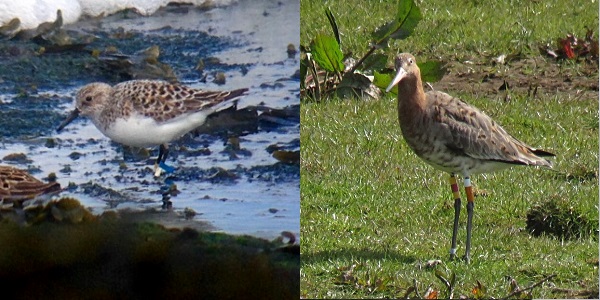
Right: Black-tailed Godwit WOO-YRY © Richard Smith
The past five weeks has seen an improvement in the number of
colour-ringed birds reported with a total of at least seven
Sanderlings, two Black-tailed Godwits and two Little Terns, plus a
Knot,
which had previously been seen on the Dee Estuary, was spotted for a
second time in the northern tip of Norway by Matt Thomas. However, not
all rings could be fully read and we are still waiting for feedback for
others.
Sanderlings
B3WWYW
- Ringed at Ostgronland in east Greenland on July 1st 2013 and was in
the same area until July 12th 2013.
Recorded on Hilbre May 16th, 2016.
On May 27th 2016 a flock of around 475
arrived at Hilbre just after high tide. They didn't stay long but at
least six were colour-ringed and the complete combinations were
recorded for four of them by Hilbre Bird Observatory, all with
different coloured flags. These were ringed in the
Netherlands, Iceland, Mauritania and Ghana, the latter easily the
furthest south ringed bird of any species in our database. It is very
likely that all this flock spent the winter in Africa, and they can get
as far as South Africa - it would be nice to get one that was ringed
there!
Black-tailed Godwit
WOO-YRY.
Ringed at Seaton Marshes, Axe Estuary in east Devon, England, on
February 9th 2013.
Recorded at Gilroy Nature Park, West Kirby, on April 21st and 22nd 2016.
Also recorded in Genets, France (south-west Normandy), in July and
August 2013.
Knot
Y flag (letters LCK) - R. Ringed at Marnes in northern Norway on May 26th 2009.Only record away from Norway was on Thurstaston shore on February 20th 2010.
Recorded by Matt Thomas at Porsanger, north Norway, on May 19th 2014 and May 24th 2016.
Little Tern
IJN on green ring. Ringed at Kilcoole, County Wicklow, east Ireland, on July 24th 2014 as a chick.Recorded at Gronant on May 26th 2016, and still present on June 1st.
Richard
Smith and Matt Thomas.
Colour-ringed birds were also recorded by Steve Williams (Hilbre
Bird Observatory), Henry Cook, Alan Irving and John Jakeman.
May Bird News
"At about 1135hrs observers were returning to the Obs when their attention was drawn to the Obs fence where a number of small birds of varying species had alighted in a row - Linnet, Meadow and Rock Pipit and a male Pied Wagtail all seemed interested in this corner of the Obs garden. A look over the fence revealed their interest was a superb male Nightjar sat on the bench in the Obs garden... A superb bird - only the third record for the island and the first for 48 years; the first on 30th August 1965 was trapped and ringed, the second was seen on 28th May 1968."
The above extract from the Hilbre Bird Observatory Blog on May 12th says it all! Nightjars used to breed on Wirral but that was well over 50 years ago, there have been recent increases in North Wales so it is quite possible we will get more frequent visits in future.
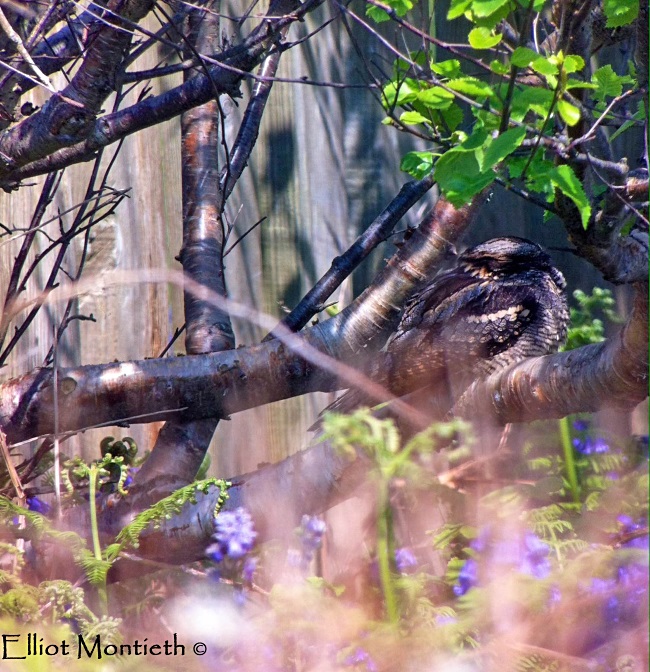
https://elliotsbirdingdiaries.wordpress.com/
The day after the excitement of the Nightjar another great rarity was
spotted, a western Subalpine Warbler at Red Rocks.
Spoonbills have been a bit thin on the ground in recent years so it was good to see one on Decca Pools which arrived on the 18th, giving good views. It remained there until the 23rd but the next day saw three there, and they subsequently flew to Burton Mere Wetlands. By the 25th there were four, 29th saw five and remarkably SIX on the 30th - five immatures and an adult. Where did they all come from!!
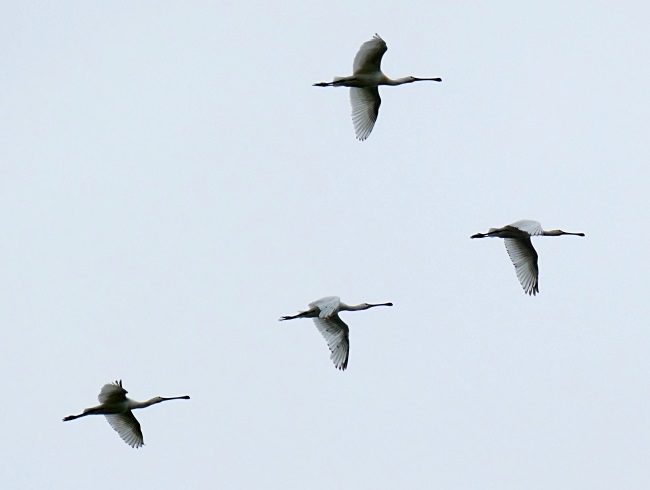
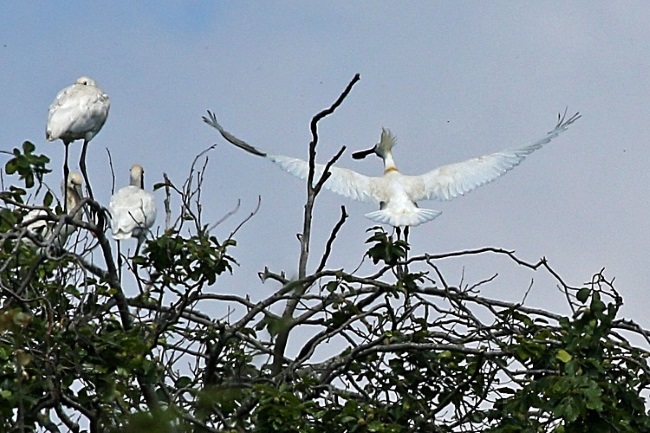
But this isn't the first time we've had six Spoonbills on the estuary with six at Inner Marsh Farm in 1998 (although one of these was a ship assisted Mauritanian Spoonbill so doesn't really count) and six also at Parkgate in 2009. What was remarkable about these records that the birds were present at the end of May, exactly the same as this year's birds.
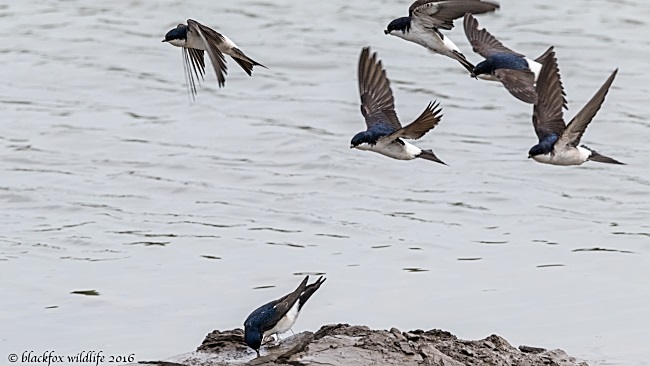
The spring migration continued through the month. It was good to have
two singing Wood Warblers at Burton Mere Wetlands on the 2nd with one
there on the 5th. Spotted Flycatchers, always the last migrants to
arrive, were in particularly good numbers with 27 in the Leasowe
Lighthouse easily a record high number for this site in recent times,
at least 10 were at Red Rocks on the 8th and there were numerous other
sightings in our area. 144 Redpolls (mostly fly-overs) was an
exceptional number at Red Rocks on the 6th. Cuckoos are becoming quite
a rare bird in the country so it was good to have 16 records this month
(eight in May 2015), which I believe is the highest number for a good
many years.
Waders passing through in May are of particular interest as most will have spent the winter well to the south of us in Africa and are heading to the far north both in north-west and north-east directions. I've already mentioned Sanderling in the Ringing Report above and these breed in Greenland. Ringed Plover of the Tundrae race winter in the whole of Africa south of the Sahara and are heading to northern Siberia whereas Dunlin, of several races, could be heading as far as Greenland in the north-west and across to Siberia in the north-east. We had good numbers of Whimbrel passing through with max of 36 at Heswall on the 4th and 45 at Hilbre on the 10th, these winter along the coast of Africa from south of Gambia right down to South Africa, and will be heading either to Iceland or Scandinavia and western Siberia. Rarer waders included a summer plumaged Little Stint at Hoylake and it continued to be a good spring for Curlew Sandpipers with two at Meols and one at Burton Mere Wetlands.
We do have breeding waders here on the
Dee estuary with the most noticeable being the Avocets at Burton Mere
Wetlands, so far they've had an excellent breeding season with at least
70 chicks counted.
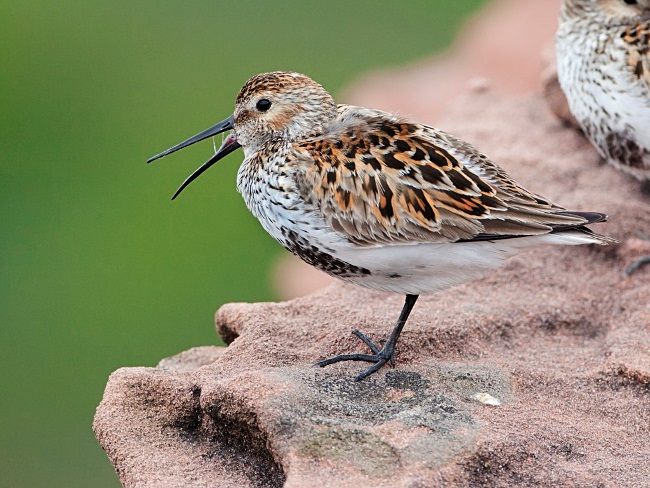 Dunlin on Hilbre, May 7th ©
Matt Thomas.
Dunlin on Hilbre, May 7th ©
Matt Thomas.
www.fromthemuddybanksofthedee.com/
Richard Smith.
What to expect in June
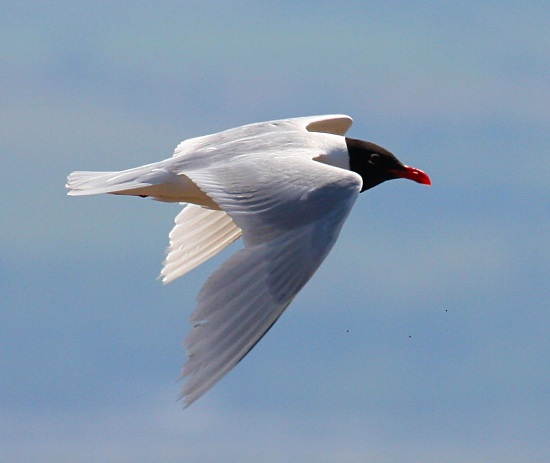
Sea watching can be very rewarding if we get strong westerlies and we can see hundreds of Manx Shearwaters flying past as well as various skuas, Fulmars and Gannets. Other interesting birds to look out for are family parties of Ravens on the marshes as well as the sound of calling Quails, we usually get one or two somewhere in our area. Rarities are very unpredicatable, of course, but the last few years have brought in a Red-necked Phalarope, Little Swift, Spotted Crake, Pectoral Sandpiper and Golden Oriole.
Top of Page
Forthcoming Events
June Highest Spring Tides (Liverpool)
Also
see Tides
page.
5th June, 11.54hrs (BST), 9.6m.
6th June, 12.44hrs (BST), 9.6m.
Forthcoming Events
Organised by the Wirral
Ranger Service , Flintshire
Countryside Service and the
RSPB (Dee Estuary):
All these events and walks have bird interest, even those not
advertised specifically for birdwatching. No need to book for these
events unless specified - please check below.
Friday 1st July, Seabird Watch at Gronant.
2pm to 4pm.
A guided tour around the Little Tern colony. A chance to ask questions aboutthe birds and why they travel 4000 miles to the edge of Prestatyn.
Meet at the Lower Gronant Car Park, SJ090836.
No need to book.
Friday 15th July, Bat and Owl night at Royden Park.
9pm to 11pm.
Join the Ranger on this evening stroll and discover where owls and bats live and hunt.
Wind/Waterproof clothing and stout footwear are essential.
Sorry no dogs.
Meet at the Coach House.
Booking essential.
For further information and to book contact midwirralrangers@wirral.gov.uk or ring 0151 648 4371.
Friday 15th July, Seabird Watch at Gronant.
2pm to 4pm.
A guided tour around the Little Tern colony. A chance to ask questions aboutthe birds and why they travel 4000 miles to the edge of Prestatyn.
Meet at the Lower Gronant Car Park, SJ090836.
No need to book.